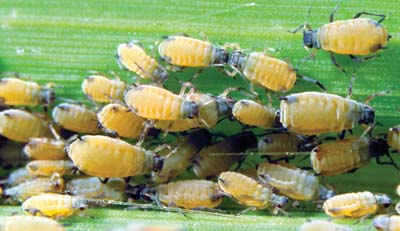To save the Web-optimized images shown below to your hard drive:
|
Click to access Display and Print quality images. |
Host plants include numerous grasses and cereal grains but the only vegetable crop that is affected is corn. Weeds that serve as alternate hosts are barnyardgrass, buffalograss, crabgrass, foxtail, and Johnsongrass. Numerous natural enemies attack corn leaf aphid and help to keep populations under control. The corn leaf aphid causes damage by feeding on the silks, leaves, and tassels of corn plants. Excrement that is produced by the aphids supports the growth of sooty mold that causes an unappealing appearance of the ears. The corn leaf aphid is capable of transmitting numerous plant viruses. Population densities can be estimated using sampling techniques such as infrared sensitive photography, sticky traps, or visual examination. Systemic insecticides can be applied to young plants or to soil, soon after plant emergence from the soil and tend to be relatively effective. In many areas, the corn leaf aphid is not considered to be a serious pest and insecticides are not applied. Cultural control techniques include early planting and host plant resistance.
Images
To save the Web-optimized images shown below to your hard drive:

Corn leaf aphids, Rhopalosiphum maidis, colony of mixed
ages.
(Photographer: P. Choate, University of Florida)
Click to access Display and Print quality images.
|
Click to access Display and Print quality images. |